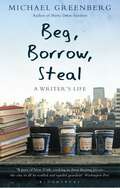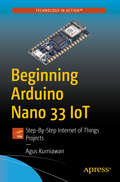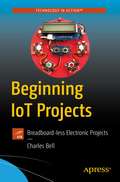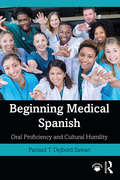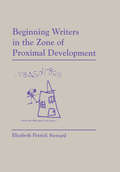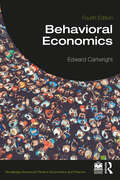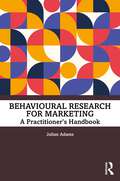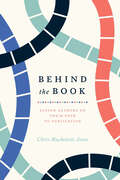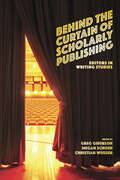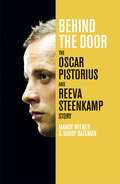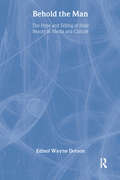- Table View
- List View
Beg, Borrow, Steal: A Writer's Life
by Michael GreenbergIn Beg, Borrow, Steal Michael Greenberg regales us with his wry and vivid take on the life of a writer of little means trying to practise his craft or simply stay alive. He finds himself doctoring doomed movie scripts; selling cosmetics from an ironing board in front of a women's department store; writing about golf, a game he has never played; and botching his debut as a waiter in a posh restaurant.Central characters include Michael's father, whose prediction that Michael's 'scribbling' wouldn't get him on the subway almost came true; his artistic first wife, whom he met in a Greenwich Village high school; and their son who grew up on the Lower East Side, fluent in the language of the street. Then there are Greenberg's unexpected encounters: a Holocaust survivor who, on his deathbed, tries to leave Michael his fortune; a repentant communist who confesses his sins; a man who becomes a woman; a Chilean film-maker in search of his past; and rats who behave like humans and cease to live underground.Hilarious and bittersweet, Greenberg's stories invite us into a world where the familial, the literary, the tragic and the mundane not only speak to one another, but deeply enjoy the exchange.
Beginning Arduino Nano 33 IoT: Step-By-Step Internet of Things Projects
by Agus KurniawanDevelop Internet of Things projects with Sketch to build your Arduino programs. This book is a quick reference guide to getting started with Nano 33 IoT, Arduino’s popular IoT board. You’ll learn how to access the Arduino I/O, understand the WiFi and BLE networks, and optimize your board by connecting it to the Arduino IoT Cloud. Arduino Nano 33 IoT is designed to build IoT solutions with supported WiFi and BLE networks. This board can be easily extend through I/O pins, sensors and actuators. Beginning Arduino Nano 33 IoT is the perfect solution for those interested in learning how to use the latest technology and project samples through a practical and content-driven approach. What You’ll LearnPrepare and set up Arduino Nano 33 IoT boardOperate Arduino Nano 33 IoT board hardware and softwareDevelop programs to access Arduino Nano 33 IoT board I/OBuild IoT programs with Arduino Nano 33 IoT boardWho This Book Is ForMakers, developers, students, and professional of all levels.
Beginning IoT Projects: Breadboard-less Electronic Projects
by Charles BellExperiment with building IoT projects without the demanding time or patience required to learn about electronics. This book thoroughly introduces readers of all ages to the world of IoT devices and electronics without getting bogged down by the overly technical aspects or being tied to a specific platform. You'll learn IoT, Arduino, Raspberry Pi from the ground up using the Qwiic and Grove components systems. The book begins with a brief overview of IoT followed by primers for the two most popular platforms; Arduino and Raspberry Pi. There is also a short tutorial on programming each host; Arduino C-like sketches and Python scripts respectfully. Thus, the book also helps you get started with your choice of platform. Next, you’ll learn the basics for the Qwiic and Grove component systems.The rest of the book presents a number of projects organized into easy-to-follow chapters that details the goal for the project, the components used, a walk-through of the code, and a challenge section that provides suggestions on how to improve or augment the project. Projects are presented for both the Arduino and Raspberry Pi where possible making each project as versatile as possible.What You'll LearnWrite Arduino sketchesCreate Python scripts for the Raspberry PiBuild IoT projects with Arduino and Raspberry PiUse the Qwiic and Grove component systemsJoin the electronics and IoT hobby world with almost no experienceHost projects data in the cloud using ThingSpeakWho This Book Is ForThose interested in building or experimenting with IoT solutions but have little or no experience working with electronics. This includes those with little or no programming experience. A secondary target would include readers interested in teaching the basics of working with Arduino and Raspberry Pi to others.
Beginning Medical Spanish: Oral Proficiency and Cultural Humility
by Parizad T. Dejbord SawanBeginning Medical Spanish. Oral Proficiency and Cultural Humility is designed for medical professionals and supporting staff with no prior knowledge of Spanish who need to develop oral language skills and cross-cultural sensitivity to establish relationship-building communication with their Spanish-speaking patients. This hospital-tested program teaches how to connect with patients of limited English-speaking ability and offer them the quality care they seek. Role-play activities allow students to develop their oral proficiency in meaningful contexts and contribute to a creative and dynamic classroom environment. Written exercises provide opportunity for practice outside the classroom, and audio recordings are available online for use in class and at home. The cultural readings and extensive bibliographical references in each chapter provide students with information about Hispanic values, beliefs and health practices, while teaching them to consider how these may vary with the identity of each individual and the degree of acculturation to US "mainstream" culture. Whether you are a student preparing to work in a medical environment, or a professional already working with Spanish-speaking patients, the innovative method of hands-on learning though role-playing practice provided in this program will give you the specific skills you need to communicate confidently and respectfully in Spanish.
Beginning Medical Spanish: Oral Proficiency and Cultural Humility
by Parizad T. Dejbord SawanBeginning Medical Spanish. Oral Proficiency and Cultural Humility is designed for medical professionals and supporting staff with no prior knowledge of Spanish who need to develop oral language skills and cross-cultural sensitivity to establish relationship-building communication with their Spanish-speaking patients. This hospital-tested program teaches how to connect with patients of limited English-speaking ability and offer them the quality care they seek. Role-play activities allow students to develop their oral proficiency in meaningful contexts and contribute to a creative and dynamic classroom environment. Written exercises provide opportunity for practice outside the classroom, and audio recordings are available online for use in class and at home. The cultural readings and extensive bibliographical references in each chapter provide students with information about Hispanic values, beliefs and health practices, while teaching them to consider how these may vary with the identity of each individual and the degree of acculturation to US "mainstream" culture. Whether you are a student preparing to work in a medical environment, or a professional already working with Spanish-speaking patients, the innovative method of hands-on learning though role-playing practice provided in this program will give you the specific skills you need to communicate confidently and respectfully in Spanish.
Beginning Writers in the Zone of Proximal Development
by Elizabeth Petrick-StewardHow do young children bridge the gap between "writing" a story with pictures and writing with words? How children learn to use written words to tell a story is a topic important to both cognitive development and early literacy instruction. Using the theoretical framework developed by Vygotsky, the behavior of a group of prekindergarten children as they author two consecutive pieces of writing is analyzed. The children tell their stories at first with spoken words and pictures. As they discuss their work-in-progress in public conferences, they discover how to build on and combine existing skills to produce a new skill -- telling stories with written words. Current descriptive and theoretical perspectives on beginning writing are presented in this volume, with a particular focus on Vygotsky's concept of the zone of proximal development, a period of sensitivity in which learning advances. The proposed mechanism of change is verbal mediation -- talk among peers and teachers as they discuss work-in-progress -- which moves the children through the zone of proximal development. An open, whole-language approach to literacy instruction makes the classroom in this book an ideal arena in which to observe verbal mediation in operation. Children are free to question, criticize and argue; and in the process they collectively advance their developing ability to use written language. The work is unique in that the rich and comprehensive data record is reproduced in its entirety. More than 400 illustrations of the children's products -- two "books" apiece, pictured before and after the children's revisions -- are included, along with transcripts of the conferences about each of the pages, permitting direct observation of the effects of verbal mediation. This dynamic study documents change during a period of time when specific learning is occurring, and provides strong support for the value and power of Vygotsky's theoretical framework.
Beginning Writers in the Zone of Proximal Development
by Elizabeth Petrick-StewardHow do young children bridge the gap between "writing" a story with pictures and writing with words? How children learn to use written words to tell a story is a topic important to both cognitive development and early literacy instruction. Using the theoretical framework developed by Vygotsky, the behavior of a group of prekindergarten children as they author two consecutive pieces of writing is analyzed. The children tell their stories at first with spoken words and pictures. As they discuss their work-in-progress in public conferences, they discover how to build on and combine existing skills to produce a new skill -- telling stories with written words. Current descriptive and theoretical perspectives on beginning writing are presented in this volume, with a particular focus on Vygotsky's concept of the zone of proximal development, a period of sensitivity in which learning advances. The proposed mechanism of change is verbal mediation -- talk among peers and teachers as they discuss work-in-progress -- which moves the children through the zone of proximal development. An open, whole-language approach to literacy instruction makes the classroom in this book an ideal arena in which to observe verbal mediation in operation. Children are free to question, criticize and argue; and in the process they collectively advance their developing ability to use written language. The work is unique in that the rich and comprehensive data record is reproduced in its entirety. More than 400 illustrations of the children's products -- two "books" apiece, pictured before and after the children's revisions -- are included, along with transcripts of the conferences about each of the pages, permitting direct observation of the effects of verbal mediation. This dynamic study documents change during a period of time when specific learning is occurring, and provides strong support for the value and power of Vygotsky's theoretical framework.
Behavioral Economics (Routledge Advanced Texts in Economics and Finance)
by Edward CartwrightOver the last few decades behavioral economics has revolutionized the discipline. It has done so by putting the human back into economics, by recognizing that people sometimes make mistakes, care about others and are generally not as cold and calculating as economists have traditionally assumed. The results have been exciting and fascinating, and have fundamentally changed the way we look at economic behavior. This textbook introduces all the key results and insights of behavioral economics to a student audience. Ideas such as mental accounting, prospect theory, present bias, inequality aversion and learning are explained in detail. These ideas are also applied in diverse settings such as auctions, stock market crashes, charitable donations and health care, to show why behavioral economics is crucial to understanding the world around us. Consideration is also given to what makes people happy, and how we can potentially nudge people to be happier. This new edition contains expanded and updated coverage of contract theory, bargaining in the family, time and risk, and stochastic reference points, among other topics, to ensure that readers are kept up to speed with this fast-paced field. The companion website is also updated with a range of new questions and worked examples. This book remains the ideal introduction to behavioral economics for advanced undergraduate and graduate students.
Behavioral Economics (Routledge Advanced Texts in Economics and Finance)
by Edward CartwrightOver the last few decades behavioral economics has revolutionized the discipline. It has done so by putting the human back into economics, by recognizing that people sometimes make mistakes, care about others and are generally not as cold and calculating as economists have traditionally assumed. The results have been exciting and fascinating, and have fundamentally changed the way we look at economic behavior. This textbook introduces all the key results and insights of behavioral economics to a student audience. Ideas such as mental accounting, prospect theory, present bias, inequality aversion and learning are explained in detail. These ideas are also applied in diverse settings such as auctions, stock market crashes, charitable donations and health care, to show why behavioral economics is crucial to understanding the world around us. Consideration is also given to what makes people happy, and how we can potentially nudge people to be happier. This new edition contains expanded and updated coverage of contract theory, bargaining in the family, time and risk, and stochastic reference points, among other topics, to ensure that readers are kept up to speed with this fast-paced field. The companion website is also updated with a range of new questions and worked examples. This book remains the ideal introduction to behavioral economics for advanced undergraduate and graduate students.
Behavioral Economics (Routledge Advanced Texts in Economics and Finance)
by Edward CartwrightOver the last few decades behavioral economics has revolutionized the discipline. It has done so by putting the human back into economics, by recognizing that people sometimes make mistakes, care about others and are generally not as cold and calculating as economists have traditionally assumed. The results have been exciting and fascinating, and have fundamentally changed the way we look at economic behavior. This textbook introduces all the key results and insights of behavioral economics to a student audience. Ideas such as mental accounting, prospect theory, present bias, inequality aversion and learning are explained in detail. These ideas are also applied in diverse settings, such as auctions, stock market crashes, charitable donations and health care, to show why behavioral economics is crucial to understanding the world around us. Consideration is also given to what makes people happy, and how we can potentially nudge people to be happier. This new edition contains expanded and updated coverage of several topics and applications, including fraud and cybercrime, cryptocurrency, public health messaging, and the COVID-19 pandemic. The companion website is also updated with a range of new questions and worked examples. This book remains the ideal introduction to behavioral economics for advanced undergraduate and graduate students.
Behavioral Economics (Routledge Advanced Texts in Economics and Finance)
by Edward CartwrightOver the last few decades behavioral economics has revolutionized the discipline. It has done so by putting the human back into economics, by recognizing that people sometimes make mistakes, care about others and are generally not as cold and calculating as economists have traditionally assumed. The results have been exciting and fascinating, and have fundamentally changed the way we look at economic behavior. This textbook introduces all the key results and insights of behavioral economics to a student audience. Ideas such as mental accounting, prospect theory, present bias, inequality aversion and learning are explained in detail. These ideas are also applied in diverse settings, such as auctions, stock market crashes, charitable donations and health care, to show why behavioral economics is crucial to understanding the world around us. Consideration is also given to what makes people happy, and how we can potentially nudge people to be happier. This new edition contains expanded and updated coverage of several topics and applications, including fraud and cybercrime, cryptocurrency, public health messaging, and the COVID-19 pandemic. The companion website is also updated with a range of new questions and worked examples. This book remains the ideal introduction to behavioral economics for advanced undergraduate and graduate students.
Behavioural Research for Marketing: A Practitioner's Handbook
by Julian AdamsThis book, the first of its kind, provides market researchers and marketeers with the tools to better understand human behaviour by drawing upon social science theory from different schools of thought, including sociology, psychology and behavioural economics. It has practical examples throughout to help illustrate how to operationalise theory in market research and to underpin the way we understand how people think, behave, decide and make choices. Each theory is explained in accessible terms to ensure that the content is relevant and useful to commercial market researchers. By considering different theoretical models of human behaviour from the outset, this book will open new avenues of investigation, help researchers to develop more dynamic and challenging hypotheses to test during the research process, and ultimately result in more insightful outcomes. The book brings together theories that look at how society is shaped and formed, and how this impacts on the individual, along with theories that focus on the mind and behaviour of the individual; these perspectives are equally important in market research but not usually considered within the same text. This book is not limited to theory alone; in each chapter, illustrative examples are used to help demonstrate how theory can be applied to real-world market research projects. Additionally, throughout there are helpful suggestions in terms of question content to help operationalise theory. This book will appeal to those that have recently entered the field of market research and are interested in the theoretical underpinnings of human behaviour, undergraduates and post-graduates that are studying marketing, business studies or social science, where a core component of the course requirement is market research, and finally those that are users of market research data and want a working knowledge of key theories of human behaviour.
Behavioural Research for Marketing: A Practitioner's Handbook
by Julian AdamsThis book, the first of its kind, provides market researchers and marketeers with the tools to better understand human behaviour by drawing upon social science theory from different schools of thought, including sociology, psychology and behavioural economics. It has practical examples throughout to help illustrate how to operationalise theory in market research and to underpin the way we understand how people think, behave, decide and make choices. Each theory is explained in accessible terms to ensure that the content is relevant and useful to commercial market researchers. By considering different theoretical models of human behaviour from the outset, this book will open new avenues of investigation, help researchers to develop more dynamic and challenging hypotheses to test during the research process, and ultimately result in more insightful outcomes. The book brings together theories that look at how society is shaped and formed, and how this impacts on the individual, along with theories that focus on the mind and behaviour of the individual; these perspectives are equally important in market research but not usually considered within the same text. This book is not limited to theory alone; in each chapter, illustrative examples are used to help demonstrate how theory can be applied to real-world market research projects. Additionally, throughout there are helpful suggestions in terms of question content to help operationalise theory. This book will appeal to those that have recently entered the field of market research and are interested in the theoretical underpinnings of human behaviour, undergraduates and post-graduates that are studying marketing, business studies or social science, where a core component of the course requirement is market research, and finally those that are users of market research data and want a working knowledge of key theories of human behaviour.
Behind the Book: Eleven Authors on Their Path to Publication (Chicago Guides to Writing, Editing, and Publishing)
by Chris Mackenzie JonesEvery book has a story of its own, a path leading from the initial idea that sparked it to its emergence into the world in published form. No two books follow quite the same path, but all are shaped by a similar array of market forces and writing craft concerns as well as by a cast of characters stretching beyond the author. Behind the Book explores how eleven contemporary first-time authors, in genres ranging from post-apocalyptic fiction to young adult fantasy to travel memoir, navigated these pathways with their debut works. Based on extensive interviews with the authors, it covers the process of writing and publishing a book from beginning to end, including idea generation, developing a process, building a support network, revising the manuscript, finding the right approach to publication, building awareness, and ultimately moving on to the next project. It also includes insights from editors, agents, publishers, and others who helped to bring these projects to life. Unlike other books on writing craft, Behind the Book looks at the larger picture of how an author’s work and choices can affect the outcome of a project. The authors profiled in each story open up about their challenges, mistakes, and successes. While their paths to publication may be unique, together they offer important lessons that authors of all types can apply to their own writing journeys.
Behind the Book: Eleven Authors on Their Path to Publication (Chicago Guides to Writing, Editing, and Publishing)
by Chris Mackenzie JonesEvery book has a story of its own, a path leading from the initial idea that sparked it to its emergence into the world in published form. No two books follow quite the same path, but all are shaped by a similar array of market forces and writing craft concerns as well as by a cast of characters stretching beyond the author. Behind the Book explores how eleven contemporary first-time authors, in genres ranging from post-apocalyptic fiction to young adult fantasy to travel memoir, navigated these pathways with their debut works. Based on extensive interviews with the authors, it covers the process of writing and publishing a book from beginning to end, including idea generation, developing a process, building a support network, revising the manuscript, finding the right approach to publication, building awareness, and ultimately moving on to the next project. It also includes insights from editors, agents, publishers, and others who helped to bring these projects to life. Unlike other books on writing craft, Behind the Book looks at the larger picture of how an author’s work and choices can affect the outcome of a project. The authors profiled in each story open up about their challenges, mistakes, and successes. While their paths to publication may be unique, together they offer important lessons that authors of all types can apply to their own writing journeys.
Behind the Book: Eleven Authors on Their Path to Publication (Chicago Guides to Writing, Editing, and Publishing)
by Chris Mackenzie JonesEvery book has a story of its own, a path leading from the initial idea that sparked it to its emergence into the world in published form. No two books follow quite the same path, but all are shaped by a similar array of market forces and writing craft concerns as well as by a cast of characters stretching beyond the author. Behind the Book explores how eleven contemporary first-time authors, in genres ranging from post-apocalyptic fiction to young adult fantasy to travel memoir, navigated these pathways with their debut works. Based on extensive interviews with the authors, it covers the process of writing and publishing a book from beginning to end, including idea generation, developing a process, building a support network, revising the manuscript, finding the right approach to publication, building awareness, and ultimately moving on to the next project. It also includes insights from editors, agents, publishers, and others who helped to bring these projects to life. Unlike other books on writing craft, Behind the Book looks at the larger picture of how an author’s work and choices can affect the outcome of a project. The authors profiled in each story open up about their challenges, mistakes, and successes. While their paths to publication may be unique, together they offer important lessons that authors of all types can apply to their own writing journeys.
Behind the Book: Eleven Authors on Their Path to Publication (Chicago Guides to Writing, Editing, and Publishing)
by Chris Mackenzie JonesEvery book has a story of its own, a path leading from the initial idea that sparked it to its emergence into the world in published form. No two books follow quite the same path, but all are shaped by a similar array of market forces and writing craft concerns as well as by a cast of characters stretching beyond the author. Behind the Book explores how eleven contemporary first-time authors, in genres ranging from post-apocalyptic fiction to young adult fantasy to travel memoir, navigated these pathways with their debut works. Based on extensive interviews with the authors, it covers the process of writing and publishing a book from beginning to end, including idea generation, developing a process, building a support network, revising the manuscript, finding the right approach to publication, building awareness, and ultimately moving on to the next project. It also includes insights from editors, agents, publishers, and others who helped to bring these projects to life. Unlike other books on writing craft, Behind the Book looks at the larger picture of how an author’s work and choices can affect the outcome of a project. The authors profiled in each story open up about their challenges, mistakes, and successes. While their paths to publication may be unique, together they offer important lessons that authors of all types can apply to their own writing journeys.
Behind the Book: Eleven Authors on Their Path to Publication (Chicago Guides to Writing, Editing, and Publishing)
by Chris Mackenzie JonesEvery book has a story of its own, a path leading from the initial idea that sparked it to its emergence into the world in published form. No two books follow quite the same path, but all are shaped by a similar array of market forces and writing craft concerns as well as by a cast of characters stretching beyond the author. Behind the Book explores how eleven contemporary first-time authors, in genres ranging from post-apocalyptic fiction to young adult fantasy to travel memoir, navigated these pathways with their debut works. Based on extensive interviews with the authors, it covers the process of writing and publishing a book from beginning to end, including idea generation, developing a process, building a support network, revising the manuscript, finding the right approach to publication, building awareness, and ultimately moving on to the next project. It also includes insights from editors, agents, publishers, and others who helped to bring these projects to life. Unlike other books on writing craft, Behind the Book looks at the larger picture of how an author’s work and choices can affect the outcome of a project. The authors profiled in each story open up about their challenges, mistakes, and successes. While their paths to publication may be unique, together they offer important lessons that authors of all types can apply to their own writing journeys.
Behind the Book: Eleven Authors on Their Path to Publication (Chicago Guides to Writing, Editing, and Publishing)
by Chris Mackenzie JonesEvery book has a story of its own, a path leading from the initial idea that sparked it to its emergence into the world in published form. No two books follow quite the same path, but all are shaped by a similar array of market forces and writing craft concerns as well as by a cast of characters stretching beyond the author. Behind the Book explores how eleven contemporary first-time authors, in genres ranging from post-apocalyptic fiction to young adult fantasy to travel memoir, navigated these pathways with their debut works. Based on extensive interviews with the authors, it covers the process of writing and publishing a book from beginning to end, including idea generation, developing a process, building a support network, revising the manuscript, finding the right approach to publication, building awareness, and ultimately moving on to the next project. It also includes insights from editors, agents, publishers, and others who helped to bring these projects to life. Unlike other books on writing craft, Behind the Book looks at the larger picture of how an author’s work and choices can affect the outcome of a project. The authors profiled in each story open up about their challenges, mistakes, and successes. While their paths to publication may be unique, together they offer important lessons that authors of all types can apply to their own writing journeys.
Behind the Curtain of Scholarly Publishing: Editors in Writing Studies
by Greg Giberson Megan Schoen Christian WeisserUntil now there has been little consideration of the intellectual and historical impact editors have had on the young and ever-evolving field of writing studies. Behind the Curtain of Scholarly Publishing provides new and seasoned scholars with behind-the-scenes explorations and expositions of the history of scholarly editing and the role of the scholarly editor from the perspectives of current and former editors from important publications within the field. Each chapter in the collection examines the unique experiences and individual contributions of its authors during their time as editors, offering advice to scholars and potential editors on how to navigate the publication process and understand editorial roles. The contributors provide multiple perspectives on the growth, transformation, and, in some cases, founding of some of the most influential publishing venues in writing studies. The personal and historical narratives, along with the unique perspectives and insightful analyses of the individual authors in Behind the Curtain of Scholarly Publishing, offer needed transparency and context to what has historically been an opaque, yet inevitable and consequential, part of academic life. This volume will help researchers in the field understand the publishing process. Contributors: Cheryl Ball, David Bartholomae, Charles Bazerman, Jean Ferguson Carr, Douglas Eyman, Muriel Harris, Byron Hawk, Alice Horning, Paul Kei Matsuda, Laura Micciche, Mike Palmquist, Michael Pemberton, Malea Powell, Kelly Ritter, Victor Villanueva, Victor Vitanza, Kathleen Blake Yancey
Behind the Door: The Oscar Pistorious And Reeva Steenkamp Story
by Mandy Wiener Barry BatemanIn February 2013 the news of successful model Reeva Steenkamp's fatal shooting by her boyfriend and global sporting star Oscar Pistorius stunned the world. Over the ensuing months, as Pistorius appeared in court, applied for bail and was eventually put on trial, every detail that emerged was analysed, debated, justified and digested. The world was haunted by the events as they were repeated and discussed at length. Public perception vacillated from version to version and from hour to hour. Finally, Judge Masipa found him to be not guilty of premeditated murder - but guilty of culpable homicide.Written by Mandy Weiner and Barry Batemen, the go-to journalists on the case for the world's media, Behind the Door is a compelling narrative that meticulously unpacks the evidence that has been so heavily scrutinised on all sides. But more than that, this book seeks to go beyond the facts of the case in search of the wider context behind this shocking tragedy: the back story of the police investigation, the nature of the South African criminal justice system, the culture of violence in South Africa and the need of society to create flawed heroes who are destined to fail.Vivid and gripping, Behind the Door is the most authoritative and insightful account of what really happened behind closed doors that fateful Valentine's morning.
Behind the Screen: Content Moderation in the Shadows of Social Media
by Sarah T. RobertsAn eye-opening look at the invisible workers who protect us from seeing humanity’s worst on today’s commercial internet Social media on the internet can be a nightmarish place. A primary shield against hateful language, violent videos, and online cruelty uploaded by users is not an algorithm. It is people. Mostly invisible by design, more than 100,000 commercial content moderators evaluate posts on mainstream social media platforms: enforcing internal policies, training artificial intelligence systems, and actively screening and removing offensive material—sometimes thousands of items per day. Sarah T. Roberts, an award-winning social media scholar, offers the first extensive ethnographic study of the commercial content moderation industry. Based on interviews with workers from Silicon Valley to the Philippines, at boutique firms and at major social media companies, she contextualizes this hidden industry and examines the emotional toll it takes on its workers. This revealing investigation of the people “behind the screen” offers insights into not only the reality of our commercial internet but the future of globalized labor in the digital age.
Behind these Doors: Stories of Strength, Suffering and Survival
by Alex South*Available to pre-order*'A true, compassionate and honest account of what it is to work in our prisons.' Dr Gwen Adshead, Sunday Times bestselling author of The Devil You Know'A vivid, unsentimental insight into a world that needs to be seen . . . a powerful reminder of how far we are from rehabilitating our prisons.' The Observer'This is a beautifully written account about hope and optimism, of humanity, realism, resilience and the complexity of people.' Professor David Wilson__________'The men I have worked with and the staff I've worked alongside over the last ten years in prison have taught me strength, compassion, courage, and fundamentally, the need to talk, the need to share and the need to tell these stories. These are the stories of lives lived, lost and taken, behind walls so high we can pretend they hide another world entirely. But at what cost?Few people leave prison unchanged. It's a place heavy with suffering, a place where you will find dangerous, vulnerable, and forgotten people. But for Alex South, it was a place where she also found hope.In this powerful and moving memoir, Alex attempts to make sense of her experiences in prison by confronting the harsh reality of life on the inside and examining them from different angles. In an overwhelmingly masculine environment, where strength and aggression are routinely on show, Alex's view is particularly important.Capturing the confusion and contradictions of prison, Alex presents a life that is often hidden from the public. Changing our perceptions, Behind These Doors shows the many devastating, but often inspiring, consequences prison can have.__________'I was completely gripped whilst reading it - it's such a powerful memoir and one that shines a light into a world most of the public rarely see.' Nikki Smith, author of The Beach Party
Behinderung im Fernsehen: Gleichberechtigte Teilhabe als Leitziel der Berichterstattung (Gesundheit und Gesellschaft)
by Ingo BosseAus Sicht der Rehabilitations- wie auch der Kommunikationswissenschaften untersucht Ingo Bosse interdisziplinär, ob sich das Leitziel gleichberechtigter Teilhabe von Menschen mit Behinderung auch auf die Darstellung von Behinderung im Fernsehen auswirkt. Er analysiert Berichterstattungsmuster quotenstarker Boulevardmagazine und geht der Frage nach, ob sie den Programmauftrag erfüllen.
Behold the Man: The Hype and Selling of Male Beauty in Media and Culture
by Edisol DotsonThe first comprehensive study of how images of male beauty are projected onto society, Behold the Man: The Hype and Selling of Male Beauty in Media and Culture examines the role media and society play in creating the image of the idealized male. This book explores how these images are interpreted by all genders and sexual orientations in order to investigate the phenomenon’s effect on the self-esteem of adolescent and adult males. Behold the Man provides you with research and examples that identify this problem from many angles to help you realize that being a man is more than merely possessing muscles and good looks.Discussing examples in which both attractive men and women are idealized as “the norm,” Behold the Man argues that men are experiencing the same injustices as women--splashed on the covers of magazines and in advertisements, based on their sex appeal, sometimes to promote nothing more than their looks. Within Behold the Man, you‘ll find topics that relate to the reasons for and effects of male beauty standards, such as: aspects of male beauty, from Ancient Greek ideals to how it is visualized throughout history in art the vision of “the ideal male,” along with sexual connotations, in advertisements for clothing, cologne, sunglasses, automobiles, and shaving products the emphasis of strong, well-built males and their bodies in movies, music videos, and literature how men alter their bodies by dieting and cosmetic surgery to achieve the look found in advertisements today’s growing numbers of male eating disorders caused by the notion that only good-looking, muscular men are acceptable reasons behind the exploitation of the male body and the double standards for male beauty found within gay male communities how advertisers and authors faithfully follow the “bigger is better” theory--from pectoral and bicep muscles to penis sizeRecognizing how society has created and changed the appearance of the ideal male, this text explains to you the danger men of all ages face who feel they need to be physically handsome to be desirable. From Behold the Man, you’ll learn about the real messages of advertising and media, the problems they cause, and that true self-worth cannot be measured by physical attributes.
